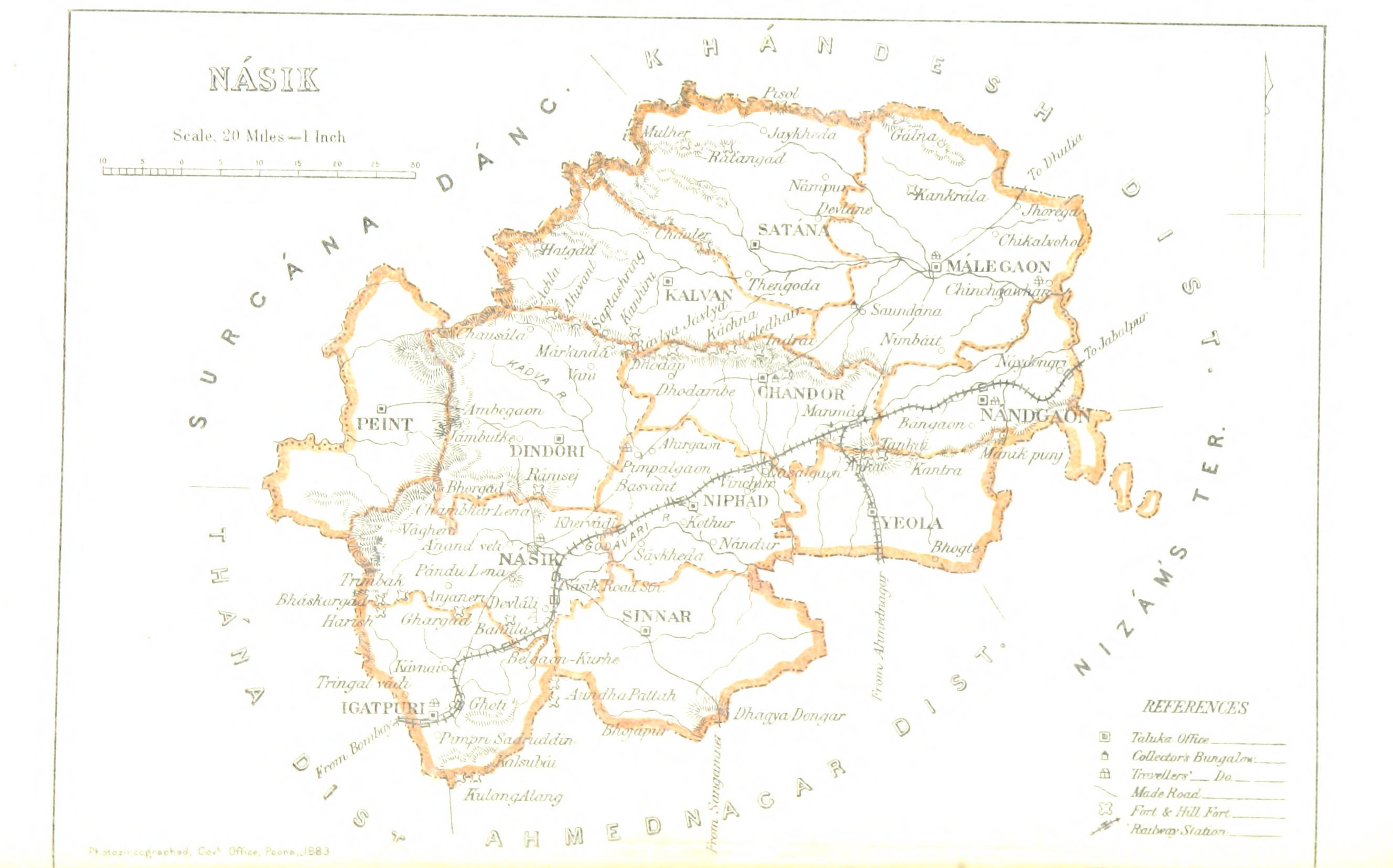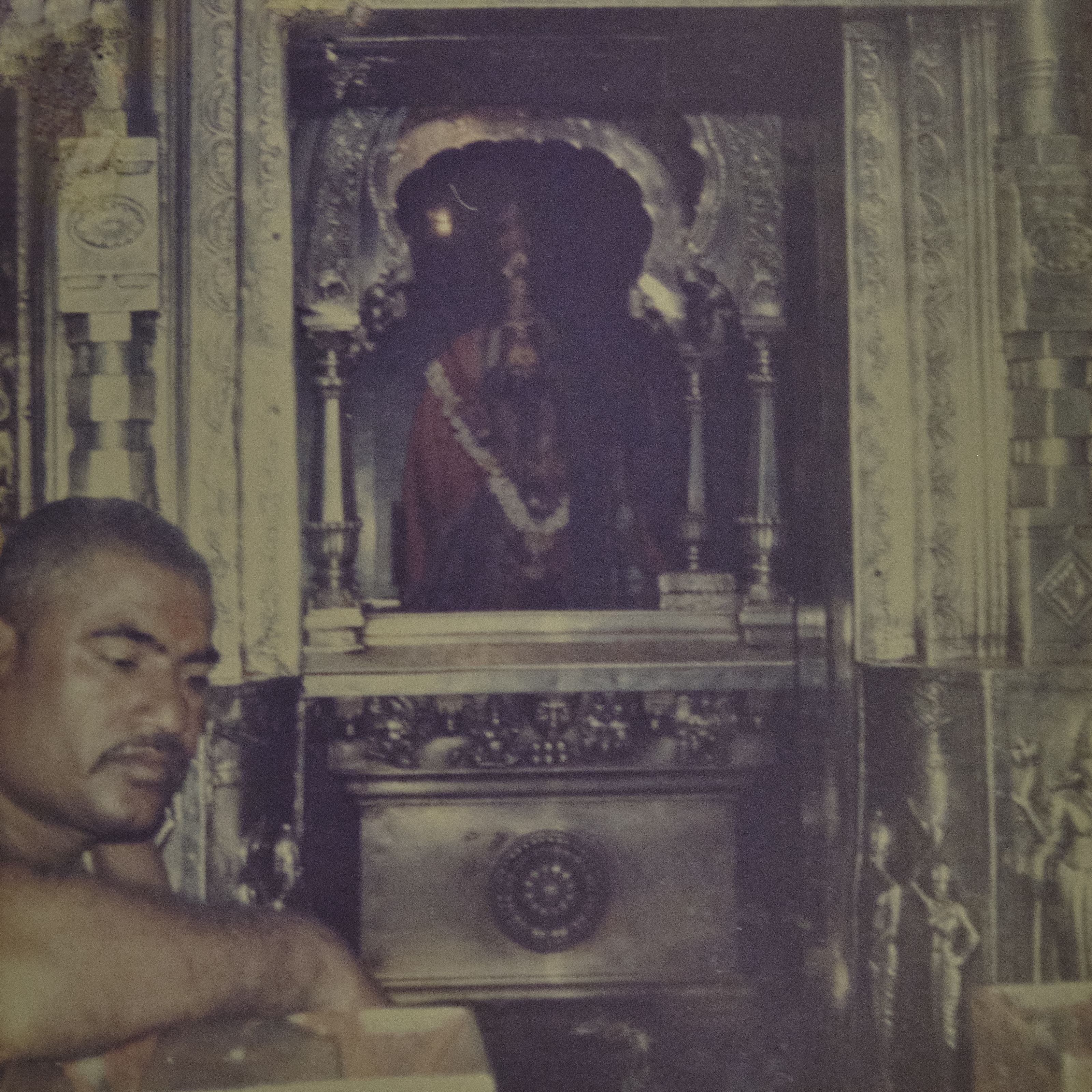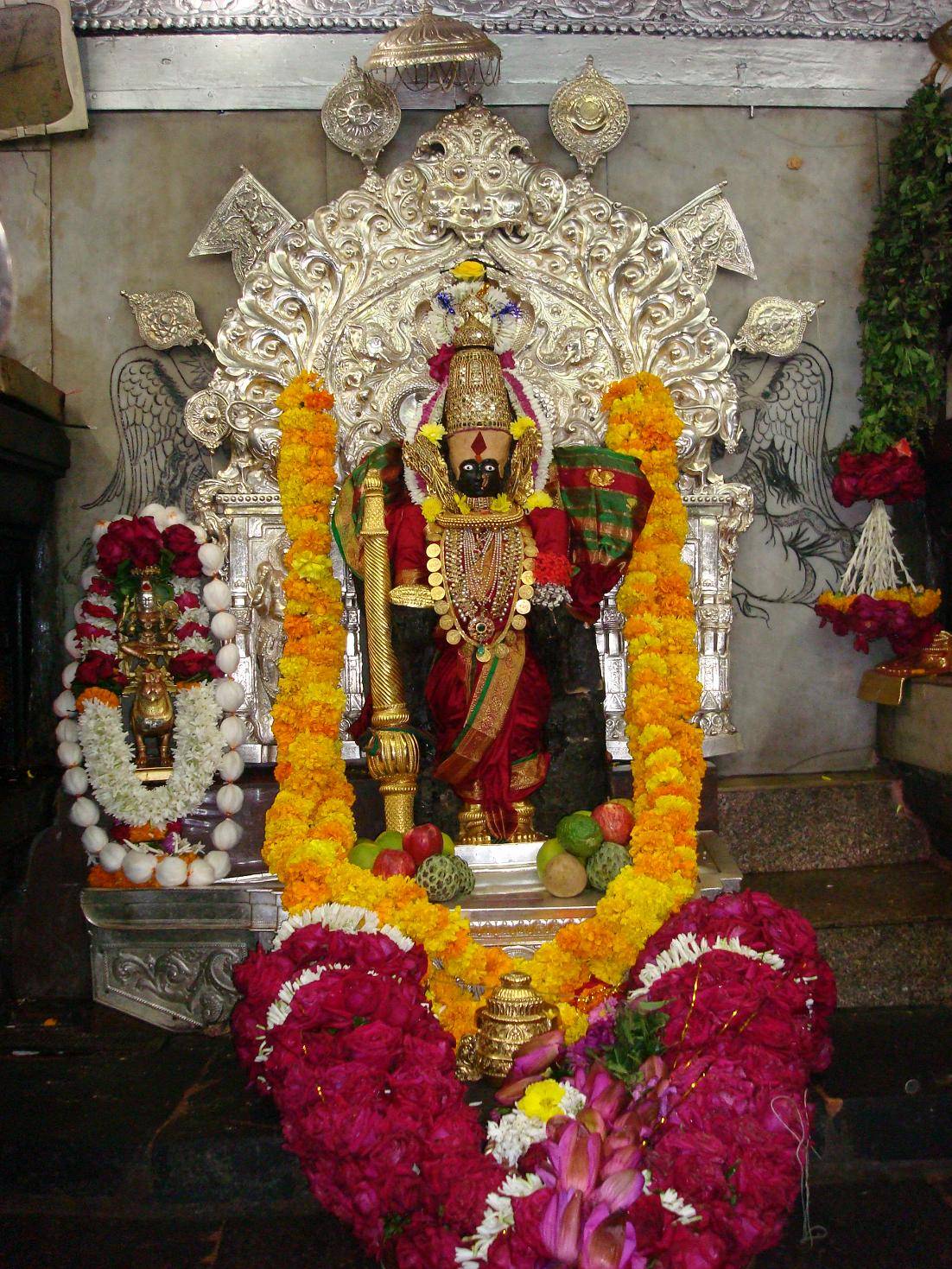|
Saptashrungi
Saptashrungi or Saptashringi (Marathi: सप्तशृङ्गि, ) is a site of Hindu pilgrimage situated from Nashik in Indian state of Maharashtra. According to Hindu traditions, the goddess Saptashrungi Nivasini dwells within the seven mountain peaks. (''Sapta'' means seven and ''shrung'' means peaks.) It is located in Nanduri, Kalwan taluka, a small village near Nashik in India. The Marathas and some Bhil tribes worship the goddess from a long time and some worship as their kuldaivat. There are 510 steps to climb the gad. Devotees visit this place in large numbers every day. The temple is also known popularly as one of the "three and half Shakti Peethas" of Maharashtra. The temple is also one among the 51 Shakti Peethas located on the Indian subcontinent and is a location where one of Sati's (wife of Lord Shiva) limbs, her right arm is reported to have fallen. Its half shaktipeeth among three and half shaktipeeth of Maharashtra. Geography Saptashrungi is a hi ... [...More Info...] [...Related Items...] OR: [Wikipedia] [Google] [Baidu] |
Kalwan
Kalwan is a tehsil in Kalwan subdivision of Nashik District in Maharashtra, India. Kalwan is situated 80 km from Nashik and 251 km from state capital Mumbai. Saptashrungi Gad, a religious shrine of Goddess Saptashrungi, is situated in Kalwan taluka. Saptashrungi Gad is located 22 km from Kalwan city. Dhodap hill fort, which is a popular mountain climbing destination and 3rd highest peak in Maharashtra Maharashtra (; , abbr. MH or Maha) is a states and union territories of India, state in the western India, western peninsular region of India occupying a substantial portion of the Deccan Plateau. Maharashtra is the List of states and union te ..., is situated 8 km from Kalwan city. Abhona is the largest town in Kalwan tehsil after Kalwan city. Official WebSite of Nashik District Kalwa ... [...More Info...] [...Related Items...] OR: [Wikipedia] [Google] [Baidu] |
Shakti Peetha
The Shakti Pitha or the Shakti Peethas ( sa, शक्ति पीठ, , ''seat of Shakti'') are significant shrines and pilgrimage destinations in Shaktism, the goddess-centric denomination in Hinduism. The shrines are dedicated to various forms of Adi Shakti. Various Puranas such as Srimad Devi Bhagavatam state the existence of varying number of 51, 64 and 108 Shakti peethas of which 18 are named as Astadasha ''Maha'' (major) in medieval Hindu texts. Various legends explain how the Shakti Peetha came into existence. The most popular is based on the story of the death of the goddess Sati. Out of grief and sorrow, Lord Shiva carried Sati's body, reminiscing about their moments as a couple, and roamed around the universe with it. Lord Vishnu had cut her body into 51 body parts, using his Sudarshana Chakra, which fell on Earth to become sacred sites where all the people can pay homage to the Goddess. To complete this massively long task, Lord Shiva took the form of Bhairava ... [...More Info...] [...Related Items...] OR: [Wikipedia] [Google] [Baidu] |
Shakti Peethas
The Shakti Pitha or the Shakti Peethas ( sa, शक्ति पीठ, , ''seat of Shakti'') are significant shrines and pilgrimage destinations in Shaktism, the goddess-centric denomination in Hinduism. The shrines are dedicated to various forms of Adi Shakti. Various Puranas such as Srimad Devi Bhagavatam state the existence of varying number of 51, 64 and 108 Shakti peethas of which 18 are named as Astadasha ''Maha'' (major) in medieval Hindu texts. Various legends explain how the Shakti Peetha came into existence. The most popular is based on the story of the death of the goddess Sati. Out of grief and sorrow, Lord Shiva carried Sati's body, reminiscing about their moments as a couple, and roamed around the universe with it. Lord Vishnu had cut her body into 51 body parts, using his Sudarshana Chakra, which fell on Earth to become sacred sites where all the people can pay homage to the Goddess. To complete this massively long task, Lord Shiva took the form of Bhairava. ... [...More Info...] [...Related Items...] OR: [Wikipedia] [Google] [Baidu] |
Nashik District
Nashik district, also known as Nasik district, is a district in Maharashtra, India. The city of Nashik is the administrative headquarters of the district. Nashik is well known for the production of wine. Nashik is also known as Mini Maharashtra, because the climate and soil conditions of Surgana, Peth, Igatpuri resembles with Konkan. Niphad, Sinnar, Dindori, Baglan blocks are like Western Maharashtra and Yeola, Nandgaon, Chandwad blocks are like Vidarbha Region. Nashik is the biggest city in the district while Malegaon is the second biggest city. Manmad, Igatpuri, sinnar are some of the big cities situated in the Nashik District. Manmad is one of the biggest railway junction in india while the city of Malegaon is famous for its powerloom. Nashik district is the third largest district in Maharashtra state in terms of population of 8,107,187 and occupying an area of 15,582 square kilometres in the north Maharashtra region. It is bounded by Dhule District to the north, Jalgao ... [...More Info...] [...Related Items...] OR: [Wikipedia] [Google] [Baidu] |
Tulja Bhavani Temple
Tulja Bhavani Temple (Marathi: श्री क्षेत्र तुळजा भवानी देवस्थान) is a Hindu temple dedicated to goddess Bhavani (goddess Parvati), also referred to as Durga and Sati. It is located in Tuljapur in Dharashiv district of Maharashtra, India, and is considered as one of the 51 Shakti Pithas. It is situated 45 km from Solapur. The temple was built in 12th century CE by Maratha Mahamandaleshwara Māradadeva of the Kadamb dynasty. The management and priestly rights of the temple are held by the Palikar Bhope clan, the descendants of Māradadeva. Goddess Tulja Bhavani is known by the names ''Tulaja'', ''Turaja'', ''Tvarita'', ''Durga'', ''Parvati'','' Tripura Sundari '',''Bhagawati'',''Amba'' (Mother of the Vedas) and Jagadambaa (Mother of the Universe) in different regions. Background Tulja Bhavani is a form of goddess Parvati, who is worshipped in Maharashtra, and also by people of Telangana, Northern Karnataka, and Ne ... [...More Info...] [...Related Items...] OR: [Wikipedia] [Google] [Baidu] |
Kolhapur
Kolhapur () is a city on the banks of the Panchganga River in the southern part of the Indian state of Maharashtra. It is the administrative headquarter of the Kolhapur district. In, around 2 C.E. Kolapur's name was 'Kuntal'. Kolhapur is known as ''`Dakshin Kashi''' or Kashi of the South because of its spiritual history and the antiquity of its shrine Mahalaxmi, better known as Ambabai. The region is known for the production of the famous hand-crafted and braided leather slippers called Kolhapuri chappal, which received the Geographical Indication designation in 2019. In Hindu mythology, the city is referred to as "''Karvir''." Before India became independent in 1947, Kolhapur was a princely state under the Bhosale Chhatrapati of the Maratha Empire. It is an important center for the Marathi film industry. Etymology Kolhapur is named after Kolhasur, a demon in Hindu History. According to History, the demon Kolhasur renounced asceticism after his sons were killed by G ... [...More Info...] [...Related Items...] OR: [Wikipedia] [Google] [Baidu] |
Mahalakshmi Temple, Kolhapur
Ambabai Temple (also known as Mahalaxmi Mandir) is an important Hindu temple dedicated to Goddess Lakshmi, who resides here as Supreme Mother Mahalakshmi and is worshipped by locals as Ambabai. Goddess Mahalakshmi is the consort of Lord Vishnu and it is customary among Hindus to visit Tirumala Venkateswara Temple, Kolhapur Mahalakshmi Temple and Padmavathi Temple as a yatra (pilgrimage). It is believed that visiting these temples as a pilgrimage helps achieve moksha (salvation). Description The temple of the goddess Mahalakshmi was built by Karnadeva in 634 CE Chalukya reign. Mounted on a stone platform, the ''murti'' of the crowned goddess is made of gemstone and weighs about 40 kilograms. The image of Mahalakshmi carved in black stone is 3 feet in height. The Shri Yantra is carved on one of the walls in the temple. A stone lion (the vahana of the goddess), stands behind the statue. The crown contains a five headed snake. Further, she holds a Matulinga fruit, mace, shield and ... [...More Info...] [...Related Items...] OR: [Wikipedia] [Google] [Baidu] |
Tuljapur
Tuljapur is a town with a municipal council in Osmanabad district in the Indian state of Maharashtra. It is the administrative seat of Tuljapur taluka. Tuljapur is the location of the annual Tulja Bhavani fair during Navaratri (September–October). The town is home to the Tulja Bhavani Temple. Geography It has an elevation of 648 metres (2125 feet). Demographics India census, Tuljapur had a population of 31,714. Males constituted 52% of the population and females 48%. Tuljapur had an average literacy rate of 69%, higher than the national average of 59.5%: male literacy was 76%, and female literacy was 60%. In 2001 in Tuljapur, 14% of the population was under 6 years of age. Marathi is spoken here. Culture The Tulja Bhavani Temple is dedicated to the Hindu goddess Bhavani. The town has received much notice during past centuries since the temple has always enjoyed a special association with the Bhosale clan to which Chhatrapati Shivaji belonged. Goddess Bha ... [...More Info...] [...Related Items...] OR: [Wikipedia] [Google] [Baidu] |
Vani
Vani ( ka, ვანი) is a town in Imereti region of a western Georgia, at the Sulori river (a tributary of the Rioni river), 41 km southwest from the regional capital Kutaisi. The town with the population of 3,744 (2014) is an administrative center of the Municipality of Vani comprising also 40 neighbouring villages (total area – 557 km²; population – 24,512, 2014). Systematic archaeological studies (N.Khoshtaria, O.Lortkiphanidze) carried out in the Vani environs since 1947 revealed the remnants of a rich city of the ancient power of Colchis. The name of this ancient settlement is still unknown but four distinct stages of uninterrupted occupation have been identified. The first phase is dated to the 8th to 7th centuries BC. In this period Vani is presumed to have been a major cultic centre. The second phase - end of the 7th and beginning of the 6th to the first half of the 4th century BC - is represented by cultural layers, remains of wooden structures, sacri ... [...More Info...] [...Related Items...] OR: [Wikipedia] [Google] [Baidu] |
Renuka
Renuka, also known as Yellamma, is a Hindu goddess worshipped predominantly in the South Indian states of Karnataka, Tamil Nadu, Telangana, Kerala, Andhra Pradesh and western state of Maharashtra. She is also known as the mother of Parashurama, the sixth avatar of the god Vishnu. Originally a Dravidian folk deity, she acquired the status of a mother goddess before eventually being associated with the legend of Parashurama. Names Renuka is venerated by a number of different appellations such as Yellamma, Ekvira, Ellai Amman, Padmakshi Renuka, and Ellai Amma Mahar, Kannada: ಶ್ರೀ ಯಲ್ಲಮ್ಮ ರೇಣುಕಾ, (Marathi: श्री. रेणुका / येल्लुआई, Tamil: ரேணு/ரேணுகை அம்மன், Telugu: శ్రీ రేణుక/ ఎల్లమ్మ) and is worshipped as the goddess of the fallen in the Hindu pantheon. Her devotees revere her as the "Mother of the universe" or Jagadamba. Legends The legen ... [...More Info...] [...Related Items...] OR: [Wikipedia] [Google] [Baidu] |
Parikrama
Parikrama or Pradakshina is clockwise circumambulation of sacred entities, and the path along which this is performed, as practiced in the Indic religions - Hinduism, Buddhism, Sikhism and Jainism. In Buddhism, it refers only to the path along which this is performed. Typically, in Indic-religions the parikrama is done after completion of traditional worship ( puja) and after paying homage to the deity. Parikrama must be done with dhyāna (spiritual contemplation and meditation). In Hinduism, parikarma of religious deities in a temple, sacred rivers, sacred hills and a close cluster of temples as a symbol of prayer is an integral part of Hindu worship.http://www.hindunet.org/faq/fom-serv/cache/31.html Why do we perform Pradakshina or Parikrama?http://www.hinduism.co.za/kaabaa.htm Kaaba a Hindu Temple?Hindus invariably circumambulate around their deities Hindu temple architecture include various Pradakshina paths. There could a parikarma path surrounding the chief deity, an ... [...More Info...] [...Related Items...] OR: [Wikipedia] [Google] [Baidu] |
Medicinal Herbs
Medicinal plants, also called medicinal herbs, have been discovered and used in traditional medicine practices since prehistoric times. Plants synthesize hundreds of chemical compounds for various functions, including defense and protection against insects, fungi, diseases, and herbivorous mammals. The earliest historical records of herbs are found from the Sumerian civilization, where hundreds of medicinal plants including opium are listed on clay tablets, c. 3000 BC. The Ebers Papyrus from ancient Egypt, c. 1550 BC, describes over 850 plant medicines. The Greek physician Dioscorides, who worked in the Roman army, documented over 1000 recipes for medicines using over 600 medicinal plants in ''De materia medica'', c. 60 AD; this formed the basis of pharmacopoeias for some 1500 years. Drug research sometimes makes use of ethnobotany to search for pharmacologically active substances, and this approach has yielded hundreds of useful compounds. These include the common drugs aspi ... [...More Info...] [...Related Items...] OR: [Wikipedia] [Google] [Baidu] |








